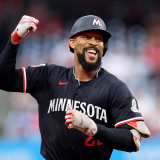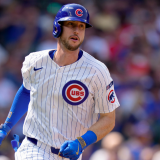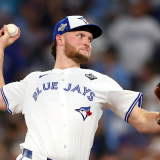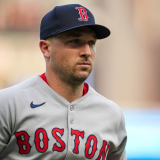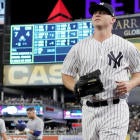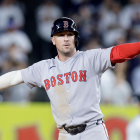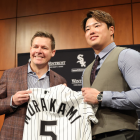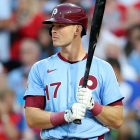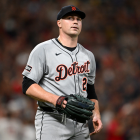MLB trade deadline grades: Yankees, Dodgers, Diamondbacks stand out among buyers
The non-waiver trade deadline is behind us, so let's pass judgment on the buyers
The non-waiver trade deadline is freshly behind us, and indeed bevy of deals went down before time ran out on Tuesday. At this point, the baseball onlooker is probably trying to make sense of everything. Because we are of, for, and by the people, we're here to help you do just that.
For this particular piece of hot content, we'll hand out grades for each contender who added roster help leading up to the deadline -- i.e., the buyers. The criterion is simple: the extent to which they helped their greater goals in 2018. You can find our grades for sellers here.
Baseball ops professionals, prepare to proudly present and or forge the following report cards. For these purposes, we're counting the July 18 Manny Machado blockbuster as the beginning of the trade deadline season for 2018, so trades since that point will be considered for grades ...
 Arizona Diamondbacks: A
Arizona Diamondbacks: A
- Received: LHP Jake Diekman, RHP Brad Ziegler, IF Eduardo Escobar, RHP Matt Andriese
- Traded: RHP Wei-Chieh Huang, RHP Tommy Eveld, RHP Jhoan Duran, OF Gabriel Maciel, OF Ernie De La Trinidad, RHP Brian Shaffer, C Michael Perez, player to be named
- Kept: RHP Jon Duplantier, 1B Pavin Smith
Assuming health, the D-Backs already have a strong rotation. Add these names to an already strong bullpen, and you've got a relief corps that compares favorably to that of any team not named the Yankees. The Diekman addition is particularly noteworthy since Arizona was light on depth from the left side. As well, Escobar stabilizes third base and becomes the only switch-hitter in the lineup. He also provides depth at short and second.
 Atlanta Braves: B+
Atlanta Braves: B+
- Received: RHP Kevin Gausman, RHP Darren O'Day, OF Adam Duvall, RHP Brad Brach, LHP Johnny Venters
- Traded: RHP Evan Phillips, INF Jean Carlos Encarnacion, C Brett Cumberland, LHP Bruce Zimmerman, RHP Lucas Sims, RHP Matt Wisler, OF Preston Tucker, international bonus pool money
- Kept: LHP Luiz Gohara, RHP Mike Soroka, RHP Kyle Wright, RHP Ian Anderson, 3B Austin Riley, LHP Kolby Allard, LHP Max Fried, LHP Joey Wentz
The Braves made wise use of the international bonus pool money to fortify the roster. Duvall becomes a useful platoon piece at multiple positions, Gausman gives them rotation depth and some upside, and Venters and Brach add arms from each side to the pen. The Braves wisely see Johan Camargo as a reasonable near- to mid-term solution at third base, so they resisted calls to upgrade that position. The price for Duvall was potentially high, but so much of that young pitching is still in the fold. The Braves acted like contenders without compromising the future.
 Boston Red Sox: B+
Boston Red Sox: B+
- Received: 2B Ian Kinsler, RHP Nathan Eovaldi, cash considerations
- Traded: RHP Ty Buttrey, LHP Williams Jerez, LHP Jalen Beeks
- Kept: LHP Jay Groome, 3B Michael Chavis
The Boston front office was hamstrung by a thin farm system, but they still got some good things done. Kinsler has been quite productive since his brutal start to the season, and he's still a quality baserunner and plus fielder. Slotting him in at second allows Brock Holt and Eduardo Nunez to platoon at third until Rafael Devers gets healthy. The Kinsler add helps the whole lineup flow better. Eovaldi adds a live arm to the rotation, which is key given the current injuries to Chris Sale and Eduardo Rodriguez. You can, however, argue that the Sox needed additional bullpen depth.
 Chicago Cubs: B+
Chicago Cubs: B+
- Received: RHP Brandon Kintzler, LHP Cole Hamels, RHP Jesse Chavez, cash considerations
- Traded: RHP Jhon Romero, RHP Eddie Butler, RHP Rollie Lacy, LHP Tyler Thomas, player to be named later
- Kept: RHP Adbert Alzolay
They get the bullpen depth they needed, and Hamels is another reliable veteran in the rotation. In particular, Hamels figures to benefit from going from one of the worst up-the-middle defenses (Texas) to one of the best (Kintzler's also a nice get on this front). Given the uncertainty surrounding Yu Darvish, Hamels' long history of staying generally healthy is valuable. No, he's no longer an ace, and indeed the Cubs may be a rotation without a true ace. That said, there's now depth, and that offense can make up for a number of pitching sins.
 Cleveland Indians: B
Cleveland Indians: B
- Received: OF Oscar Mercado, CF Leonys Martin, RHP Kyle Dowdy, RP Brad Hand, RP Adam Cimber
- Traded: OF Conner Capel, OF Jhon Torres, SS Willi Castro, C Francisco Mejia
- Kept: RHP Triston McKenzie, RHP Shane Bieber
The Hand and Cimber additions most assuredly fit a need and the competitive window, but they came at a high price (Mejia). Indians rooters were clamoring for a headline addition in center field, but they didn't get that. They did, however, get a reliable fly-catcher who can hit a little in Martin. As well, Mercado provides some depth at the position. In all, the playoff roster is potentially going to be better than their overall record might suggest.
 Colorado Rockies: C+
Colorado Rockies: C+
- Received: RHP Seung-Hwan Oh
- Traded: 1B Chad Spanberger, OF Forrest Wall, cash considerations
- Kept: SS Brendan Rodgers, INF Ryan McMahon, RHP Riley Pint
Oh's a quality major-league reliever, and that bullpen now has a lot of theoretical depth. That's advisable for a team that plays its home games at a mile above sea level. Perhaps, though, a team that's only a game out in a crowded NL West and just a half-game out in an even more crowded NL wild-card fray should've been more ambitious. The Rockies still have notable lineup holes and a somewhat thin rotation.
 Houston Astros: D
Houston Astros: D
- Received: RHP Roberto Osuna, RHP Ryan Pressly, C Martin Maldonado
- Traded: RHP Ken Giles, RHP Hector Perez, RHP David Paulino, RHP Jorge Alcala, OF Gilberto Celestino, LHP Patrick Sandoval, international bonus pool money
- Kept: RHP Forrest Whitley, OF Kyle Tucker, 1B/OF Yordan Alvarez, RHP J.B. Bukauskas
Some of Pressly's deep indicators suggest he's a real find, and Maldonado provides some pitch-framing and depth at catcher while Brian McCann is out. So that spares them from an F. It's the optics of trading for a player who's serving a suspension for alleged domestic abuse -- reportedly a gruesome example of domestic abuse -- and then spinning to justify it that gives them such a low mark.
 Los Angeles Dodgers: A+
Los Angeles Dodgers: A+
- Received: RHP John Axford, SS Manny Machado, 2B Brian Dozier
- Traded: RHP Corey Copping, OF Yusniel Diaz, 3B Rylan Bannon, RHP Dean Kremer, RHP Zach Pop, IF Breyvic Valera, 2B Logan Forsythe, OF Luke Raley, LHP Devin Smeltzer
- Kept: RHP Walker Buehler, OF Alex Verdugo, C Keibert Ruiz, RHP Mitchell White, RHP Yadier Alvarez, RHP Dustin May
The Dodgers of course landed the prize of the deadline in Machado. Machado's addition allowed Chris Taylor to slide over to second base, which had been the Dodgers' most glaring weak spot, and Machado also provided insurance against Justin Turner's injury problems.
Speaking of insurance, you also have Dozier. His numbers are down the season, but he has a recent history of elite power from the second base position. He's probably ticketed for a part-time role in L.A., but he's more than capable of regular duty in case injury strikes or Turner's convalescence takes longer than expected. Once again, the Dodgers have assembled impressive roster depth. Axford brings a reliable veteran hand to the bullpen.
 Milwaukee Brewers: C-
Milwaukee Brewers: C-
- Received: 2B Jonathan Schoop, 3B Mike Moustakas, RHP Joakim Soria
- Traded: INF Jonathan Villar, RHP Luis Ortiz, INF Jean Carmona, OF Brett Phillips, RHP Jorge Lopez, LHP Kodi Medeiros, RHP Wilber Perez
- Kept: 2B Keston Hiura, RHP Brandon Woodruff, RHP Corbin Burnes
The Brewers probably had the most interesting deadline, give them that. Soria is a sensible get for an already strong bullpen, but the infield situation is what's especially noteworthy.
The Moustakas trade already forced Travis Shaw to play out of position, and now the Brewers go out and get Jonathan Schoop. Do you play Schoop at second, given that he's spent at least some time there in the past? Or do put Shaw there so that only one infielder is playing out of position? Presumably Orlando Arcia is the heavily used defensive substitute? It's probably a fluid situation that will be determined by match-ups, but it's a strange one.
Milwaukee also had a clear need for starting pitching, but they didn't get anything done on that front. Instead, they added a couple of low-OBP sluggers to an offense that already ranks just 10th in the NL in that vital category. And is compromising the middle-infield defense really what you should do to an already flawed rotation?
 New York Yankees: A+
New York Yankees: A+
- Received: RHP Lance Lynn, LHP J.A. Happ, LHP Zach Britton, international bonus pool money, cash considerations
- Traded: RHP Luis Rijo, 1B/OF Tyler Austin, RHP Adam Warren, LHP Caleb Frare, 3B Brandon Drury, OF Billy McKinney, RHP Dillon Tate, RHP Cody Carroll, LHP Josh Rogers
- Kept: OF Estevan Florial, LHP Justus Sheffield, RHP Albert Abreu, RHP Chance Adams
This one's fairly simple. GM Brian Cashman addressed the need for rotation depth, and he also added another high-ceiling arm to what was already baseball's best bullpen. Given how the playoffs have become so reliever-reliant in recent years, that's a nice addition for a team that's a postseason lock.
As well, the Yankees added a great deal of international cap space, so they're poised for an active signing season on that front. They've already got one of baseball's best young talent bases, and that means more is on the way. In the meantime, the Yankees are still serious World Series contenders.
 Oakland A's: C
Oakland A's: C
- Received: RHP Jeurys Familia
- Traded: 3B William Toffey, RHP Bobby Wahl, international bonus pool money
- Kept: LHP A.J. Puk, SS Franklin Barreto, SS/OF Jorge Mateo, OF Dustin Fowler, LHP Jesus Luzardo
The A's are within spitting distance of playoff position, and they added nothing more than a walk-year reliever. Granted, Familia is a good walk-year reliever, but they had more pressing needs. They lack rotation depth, and they could also use another option in the outfield. It wasn't a disastrous deadline for Oakland by any means, but it was perhaps inadequate.
 Philadelphia Phillies: B
Philadelphia Phillies: B
- Received: LHP Aaron Loup, C Wilson Ramos, INF Asdrubal Cabrera
- Traded: RHP Jacob Waguespack, RHP Franklyn Kilome, player to be named later or cash considerations
- Kept: RHP Sixto Sanchez, RHP Adonis Medina, OF Adam Haseley, OF Mickey Moniak, RHP Franklyn Kilome, SS Arquimedes Gamboa
Solid work by the Philly front office. Ramos is the big get, as he should greatly improve the team's defensive presence behind the plate while also being able to produce with the bat. Cabrera is the badly needed multi-position infielder. No, he's not a standout fielder, but he can hit. Loup gives manager Gabe Kapler a second lefty in the pen -- not unwise in a division that includes the likes of Freddie Freeman, Bryce Harper, Juan Soto, Nick Markakis, Derek Dietrich, and Brandon Nimmo.
 Pittsburgh Pirates: B+
Pittsburgh Pirates: B+
- Received: RHP Chris Archer, RHP Keone Kela
- Traded: RHP Tyler Glasnow, OF Austin Meadows, LHP Taylor Hearn, two players to be named later
- Kept: RHP Mitch Keller, RHP Shane Baz
Hey, credit to the Pirates for moving boldly despite, per the SportsLine projection model, just a 6.4 percent chance of making the postseason. Nabbing Chris Archer, who's under team control at bargain rates through 2021, obviously upgrades the rotation and addresses a need. It's also a promising signal to a fan base that may have been jaded by the offseason trades of Andrew McCutchen and Gerrit Cole. Keone Kela is a big arm who still has years of control left. Along with Felipe Vazquez, they'll form a nasty lefty-righty tandem in the bullpen.
 Seattle Mariners: B
Seattle Mariners: B
- Received: OF Cameron Maybin, RHP Adam Warren, LHP Zach Duke, RHP Sam Tuivailala
- Traded: IF Bryson Brigman, RHP Chase De Jong, INF Ryan Costello, RHP Seth Elledge, international bonus pool money
- Kept: OF Kyle Lewis
GM Jerry Dipoto did his best to soup up the roster despite very little to trade away. He leaned into their international budget to get some things done, and Seattle now has an array of new bullpen arms to lean on. Also, Maybin's addition allows Dee Gordon to stick at second base, which helps the roster work better.


